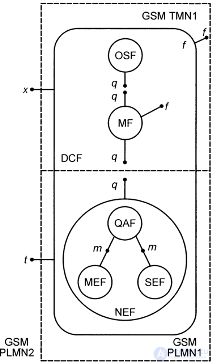Lecture
The tasks of managing communication processes in the GSM system are solved by the MLA - the Operation and Maintenance Center (Fig. 9.1).
Fig. 9.1. The control scheme of communication processes in the GSM system
 WSF
WSF
RP - control points (interfaces)
q - class of control points between OS, M and NE functions;
f - class of control points of the workstation (with subscribers of GSM networks);
e - class of control points from the workstation to the user (MMI);
x - class of working points for communication with other networks, including other TMNs;
t - non-standard internal control points;
t - control points for communication with other networks
FB - functional blocks
WSF - Workstation Function Block;
OSF - functional block of operating systems;
MF - intermediate functional unit;
DCF - GSM communication system functions associated with data transmission;
QAF - Q-interface adapter functions;
SEF - subscriber support functions;
MEF - subscriber maintenance functions;
NEF - network element functions
1. The GSM NM system should provide interaction with existing public communication systems and be their natural extension.
2. The GSM NM system must be flexible enough to allow for the future development of public land-based communication networks (PLMN), as well as network management functions and services.
3. The GSM NM system should be as transparent to the technologies used in existing PLMN as possible.
4. The GSM NM system should have a modular structure so that, regardless of the size of the network where the control is exercised, to provide the required functions.
5. The GSM NM system should not be dependent on the manufacturer, that is, it should provide for interchangeability of equipment.
6. The structure and functions of GSM NM should not limit the activities and choice of operators and manufacturers, as well as the possibility of individual use, for example, for organizing private local communication networks.
7. The GSM NM system must be fault tolerant, that is, neither equipment failure nor human factors should render the communication system or network inoperable.
The listed tasks are solved by adopting the International Standards Organization (ISO) Open Systems (OSI) for GSM networks, choosing the functional architecture of the network management system that takes into account different physical performance, and clearly defining the interface between message standards and protocols.
Comments
To leave a comment
GSM Basics
Terms: GSM Basics